Care of Canoes, Kayaks and Umiaks – Canadian Conservation Institute (CCI) Notes 6/3
Introduction
Canoes, kayaks, umiaks, and other small vessels have special display and storage problems. These watercraft are designed to receive the gentle overall support provided by water (Figure 1). When removed from water and placed on a flat surface, they become subject to localized stresses that can lead to damage (Figure 2). This damage occurs slowly as the materials conform to inadequate supports, and often goes unnoticed until it is serious and irreversible. Good support is therefore essential. The materials in watercraft also respond to changes in humidity in ways that can adversely affect the vessels.
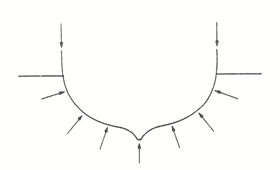
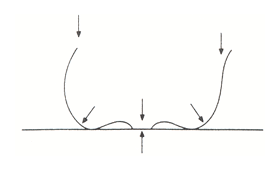
Handling
The most important aspect of handling watercraft is maintaining adequate support. To minimize the risk of damaging a vessel when it is moved, it should be left in its support mount. This can be done by using a dolly or wheeled vehicle to transport both the vessel and mount together. If this is not possible, several people should assist in the move to help maintain even support along the length of the craft. Slings made of a wide fabric banding (in the range of 10 cm) can be placed under the vessel and carried on each side. Additional people should be available to monitor the movement while the craft is manoeuvred through storage or display areas.
Storage and Display Mounts
Support mounts for watercraft should:
- be padded wherever they are in contact with the artifact (occasionally, oils and fats used to treat the skin of kayaks and umiaks create a surface that can stick to the support padding; in this case, release paper should be placed between the padding and the object)
- fit the lines of the vessel
- be positioned under the ribs of the vessel
- allow for the expansion and contraction of the vessel in response to changes in relative humidity (RH)
Storage
An ideal storage mount should imitate the even support provided by water when the vessel is afloat, but this is difficult to achieve. Pressure should be distributed as much as possible on the underside of the hull and partway up the sides to maintain the profile of the vessel.
Heavy vessels (such as dugout canoes) should be stored in padded cradles (Figure 3). Lighter objects (such as kayaks) can also be cradled or they can be stored upside down, with the gunwales resting on padded supports positioned in line with the deck beams. This allows for rack storage and saves space.
Check collections, especially those with skin coverings, for insects at least twice a year. Isolate new acquisitions from storage or display areas until it is certain that they are free of insects. For more information, consult CCI Notes 3/1 Preventing Infestations: Control Strategies and Detection Methods and 3/2 Detecting Infestations: Facility Inspection Procedure and Checklist. Immediate attention is required if an infestation is detected. Contact the Canadian Conservation Institute for advice.
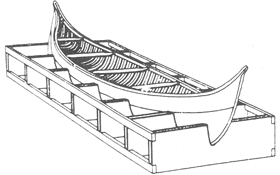
Display
Watercraft can be displayed using some version of a traditional ship's cradle: a large and complex structure for heavy vessels, or a simple series of supports shaped to fit the hull for lighter craft (Figure 4). Padded metal supports that are shaped to fit the contours of the vessel can also be used, and may be less distracting to a viewer.
For temporary support (e.g. for short-term exhibit), slings of fabric rather than a solid support may be suitable. To construct a sling, insert thin polyethylene foam (0.5–1.0 cm thick) into a sleeve of cotton and place the sleeve under the vessel so that contact is continuous to a point about halfway up the sides. Attach the ends of the sling to a rigid support on either side of the watercraft. The number of slings required will depend on the length and weight of the vessel.
Vessels displayed on an angle are at risk of deformation due to the uneven distribution of stress (Figure 5) on areas not designed to take the weight. Supports for angled display must therefore be well designed and used only on a temporary basis.
Note that these are general recommendations. Each vessel must be considered individually. If the object is damaged, its storage or display system must be designed to reduce stress on the damaged area without causing stress elsewhere. Kayaks require extra consideration as damage to their frameworks may not be obvious.
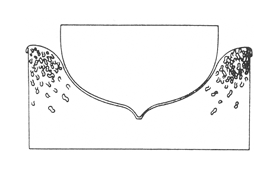
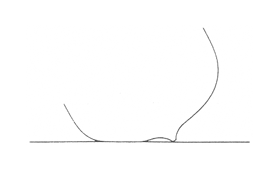
Cleaning
Always practice good housekeeping in the storage area.
Ensure that vessels, especially those with oiled surfaces, are protected from dust. Besides being unsightly, dust and dirt can hold moisture and encourage mould growth. To help reduce exposure to dust, place a loose cover of polyethylene sheeting over the vessel. If the surface of the vessel is covered with oils and fats, support the polyethylene sheeting on a framework so that it does not contact the sticky surface. If dust or dirt does accumulate on the surface of a tack-free vessel, remove it with a soft brush, directing it toward a gauze-covered vacuum cleaner nozzle. A sealed vacuum with HEPA filtration is recommended. For additional information on skin materials consult CCI Notes 8/4 Care of Rawhide and Semi-Tanned Leather.
Repair
Always consult a conservator before attempting to repair a damaged vessel (restraint or filling of cracks, for example). Use of an inappropriate material or method can cause irreparable damage. For advice, contact the Canadian Conservation Institute.
Illumination
Watercraft were traditionally made from robust materials. However, the sensitivity of a watercraft to light varies depending on the type of material and its previous exposure to light. The minimum light level required for viewing objects is 50 lux, and the maximum level suggested has traditionally been 300 lux (information on measuring light can be found in CCI Notes 2/4 Environmental Monitoring Kit (retired)). Some materials can tolerate the higher light levels (although limiting the level and duration of exposure also limits fading and deterioration) whereas other components such as fabrics or some plastics in more contemporary vessels benefit from the low light levels. If high levels are required for viewing, limit the exposure time. Also, do not place vessels under spotlights or in direct sunlight, which can heat the surface and cause thermal decay. More in-depth information on illumination and its effect on materials is available in Light, Ultraviolet and Infrared.
RH and Temperature
Wood, skin, and bark absorb moisture and are subject to shrinkage and loss of plasticity on drying. They also expand and contract, to differing degrees, in response to variations in RH. A wooden dugout will take days to respond to RH changes, but kayaks and umiaks respond in minutes because of the thinness of their materials. Skin-covered vessels in high humidity (greater than 65 % RH) can also support mould growth. When exposed to low humidity, a skin cover can quickly tighten to the point that it rips or pulls away at its seams. Under extreme conditions, the pressure may be enough to actually damage the wooden framework of the vessel. In dugout canoes, substantial cross-grain movement can occur during moisture fluctuations, resulting in checking or propagation of existing checks.
The ideal RH for intact, skin-covered vessels is 45–55 % with as little fluctuation as possible. If tears have formed in the skin and stress has been released, the structure may be able to tolerate a slightly lower RH and limited fluctuation. Large fluctuations in RH can be destructive. Temperatures should also remain as constant as possible, and should not exceed about 25 °C. Higher temperatures lead to desiccation and increased rates of chemical deterioration.
Climate Guidelines describes CCI's current approach to controlling RH and temperature in heritage institutions and provides tools to help institutions make decisions. More information regarding RH and temperature is available in Incorrect Relative Humidity and Incorrect Temperature.
Waterlogged vessels present a special case. If dried under uncontrolled conditions, they can undergo serious irreversible damage. Vessels discovered underwater should be left submerged until an archaeologist is notified and a conservator consulted.
Suppliers
Note: The following information is provided only to assist the reader. Inclusion of a company in this list does not in any way imply endorsement by the Canadian Conservation Institute.
Polyethylene sheeting:
- Suppliers of plastic products, hardware stores
Polyethylene foams:
- Contact manufacturers for local distributors:
- Plastazoate
Zotefoams - Ethafoam
Dow Chemical - Volara
Voltek
- Plastazoate
Release paper:
- archival materials suppliers, art supply stores (dry mounting materials)
Bibliography
Canadian Conservation Institute. Tear Repair of Skins with Minimal Access to their Back: The Treatment of a Kayak.
Stone, T., and F. Davidson. "CCI Innovation and Collaboration at Work in the Restoration of Banting's Kayak." CCI Newsletter 27 (), pp. 1–2.
Acknowledgements
The Canadian Conservation Institute gratefully acknowledges the assistance of Alex Barbour of Parks Canada in illustrating this Note.
by Tom Stone
revised by Janet Mason and Tom Stone
Originally published
Revised ,
Copies are also available in French.
Texte également publié en version française.
©Minister of Public Works and Government Services Canada,
Cat. Nº NM 95-57/6-3-2010E
ISSN 0714-6221